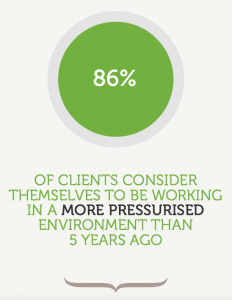
10/04/2024
Delivering value for money – a complex challenge
By Jonathan Kirk, Founder, Up to the Light and DBA Expert
One of the more concerning findings in our new ‘What Clients Think’ report relates to declining perceptions of value for money. In 2014, 66% of clients considered their agency to be good value for money but this has decreased to only 45% in 2024. This is an important message to agencies because value for money is a key ingredient of any successful client/agency relationship. So, why the decline?
 Firstly, we need to consider the context. 86% of clients consider themselves to be working in a more pressurised environment than five years ago.
Firstly, we need to consider the context. 86% of clients consider themselves to be working in a more pressurised environment than five years ago.
This often means tighter budgets, smaller client teams, a more ruthless focus on return on investment and the feeling of having to do more with less. Consequently, clients are generally looking for greater levels of proactivity and added value from their agencies. They rely on agencies more and more to be their eyes and ears, monitoring competitors and trends.
36% of clients would like their agency to ‘push boundaries’ more in terms of creativity that differentiates and disrupts. This is an environment where clients are bound to be more demanding of their agencies. Is it any wonder, then, that fewer clients are giving an unqualified ‘Yes’ to the value for money question? However, before we all begin to relax about the issue and simply blame the wider context, there are some specific factors that we should take seriously.
There are a range of issues, regularly raised by clients in our interviews, that negatively impact upon their perceptions of value for money. These fall into three areas. Firstly, those related directly to costs.
Some clients accept that front-end conceptual work is charged at a premium but question why other types of work, more implementation in character, appear to be charged at a similar rate. Other clients complain of a lack of transparency around how long some tasks really take and who is working on them. Clients also comment that the gold standard approach isn’t always necessary. Some tasks are in the ‘just get it done’ category and don’t need a juggernaut process. They talk about the need for greater pragmatism and a demonstration that the agency is ‘on our side.’
Another bugbear is misalignment on the scope of work and disagreement about what is covered in the cost and what isn’t. This often comes down to a lack of adequate up-front discussions and forward planning. Another concern is that the agency’s day-to-day client contacts may feel that their agency represents good value for money, but senior management disagree. There is a failure to show senior management the value of creativity and the return on investment it can bring.
 The second area that affects value for money is the quality of client service. No matter how good the end result, if the process of getting there was painful, then perceptions of value for money will suffer. Clients often mention the difference between simply managing a project versus really driving it. ‘Driving it’ means taking ownership, being totally on top of every aspect, excelling at communications and being forceful with the client when necessary. Failing to drive projects in this way results in more client input being needed. Client time is now at a premium, so anything that impinges on that is a negative in clients’ eyes.
The second area that affects value for money is the quality of client service. No matter how good the end result, if the process of getting there was painful, then perceptions of value for money will suffer. Clients often mention the difference between simply managing a project versus really driving it. ‘Driving it’ means taking ownership, being totally on top of every aspect, excelling at communications and being forceful with the client when necessary. Failing to drive projects in this way results in more client input being needed. Client time is now at a premium, so anything that impinges on that is a negative in clients’ eyes.
Clients are particularly sensitive to any indication that their business is perhaps not quite as valued as it used to be. Clients often mention any sort of drop in responsiveness or proactivity levels. Another indication is when agency leaders are no longer checking in as much with clients and that feeling of strategic oversight has lapsed. Also, if the agency is obviously doing well and winning new clients, but client service is seen to suffer in any way, then clients can be quick to believe that the agency’s attention and effort is going into new clients at the expense of existing ones.
The third area affecting perceptions of value for money concerns final delivery. The most serious client criticisms are around the promise of the original concept not being fully realised. In other words, it all seemed great in the studio but was it really workable? There is a consequent feeling that the agency either weren’t honest enough in their explanation of the original concept or weren’t realistic enough about its practical application. Unforeseen production issues and problems with third parties are all capable of causing strained agency/client relationships and the accusation that the agency is ‘hiding problems’.
Value for money, therefore, is a complex area and in effect, clients are judging the fully rounded client/agency relationship, not just the work and its cost.

 Firstly, we need to consider the context. 86% of clients consider themselves to be working in a more pressurised environment than five years ago.
Firstly, we need to consider the context. 86% of clients consider themselves to be working in a more pressurised environment than five years ago. The second area that affects value for money is the quality of client service. No matter how good the end result, if the process of getting there was painful, then perceptions of value for money will suffer. Clients often mention the difference between simply managing a project versus really driving it. ‘Driving it’ means taking ownership, being totally on top of every aspect, excelling at communications and being forceful with the client when necessary. Failing to drive projects in this way results in more client input being needed. Client time is now at a premium, so anything that impinges on that is a negative in clients’ eyes.
The second area that affects value for money is the quality of client service. No matter how good the end result, if the process of getting there was painful, then perceptions of value for money will suffer. Clients often mention the difference between simply managing a project versus really driving it. ‘Driving it’ means taking ownership, being totally on top of every aspect, excelling at communications and being forceful with the client when necessary. Failing to drive projects in this way results in more client input being needed. Client time is now at a premium, so anything that impinges on that is a negative in clients’ eyes.